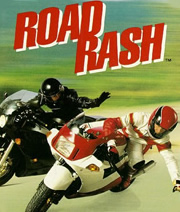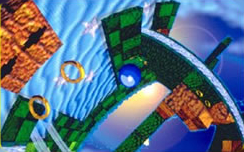Few people have been around the U.S. home gaming scene as long as Mike Wallis has. From his early days creating PC titles at Electronic Arts, working on John Madden Football and Road Rash, to his founding of the MMO-focused group Colony Studios, Wallis has seen virtually every facet of the business.
 Wallis also spent several years at Sega, where he worked with the Sega Technical Institute and later the Saturn. During his tenure as producer, he oversaw the release of such titles as Comix Zone, Sonic 3D Blast, and NBA Action ’98. While he’d been around Sega’s famous hedgehog for quite some time, little could prepare Wallis for the almost soul-breaking endeavor that became Sonic Xtreme. Initially conceived as a 32X title, it would eventually go through several iterations on the Saturn before being cancelled in 1996.
Wallis also spent several years at Sega, where he worked with the Sega Technical Institute and later the Saturn. During his tenure as producer, he oversaw the release of such titles as Comix Zone, Sonic 3D Blast, and NBA Action ’98. While he’d been around Sega’s famous hedgehog for quite some time, little could prepare Wallis for the almost soul-breaking endeavor that became Sonic Xtreme. Initially conceived as a 32X title, it would eventually go through several iterations on the Saturn before being cancelled in 1996.
Recently, Mr. Wallis spoke to Sega-16 about his time at the Sega Technical Institute.
Sega-16: According to the information available, you began your career at Electronic Arts. What was it like there during this time? It was reportedly quite different from other corporate environments of the era. Was it really as cool as it sounds?
Mike Wallis: I got my start at EA when there were approximately 120 employees at the company. While there was a lot of work to do, the employees seemed to be a relatively tight knit group and because the company was small, everyone knew each other. There were a lot of Nerf ball fights, weekly Friday company meetings with beer (I was too young to drink at the time, so none for me), movie outings, BBQ’s, and other fun events. It definitely fostered camaraderie among the staff and made for a strong creative environment. In summary, yes, it was as cool (and probably cooler) than it sounds.
Sega-16: Electronic Arts was one of the first U.S. publishers to support the Genesis, and it had at first decided against supporting Nintendo’s 8-bit system because the hardware wasn’t as powerful as computers of the time. Do you know if EA initially considered the Genesis a contender and worth getting completely behind, or was the console something to supplement its PC business?
Mike Wallis: EA did support the Nintendo 8-bit with products such as Skate or Die, but you’re right, it wasn’t a full-blown effort. That was in part due to Nintendo’s stranglehold on the third party developers and their manufacturing mandates. Sega seemed to be much more willing to work with EA and turned out to be less restrictive than Nintendo. EA had evaluated Sega’s technology and thought it was great, even though at the time the Sega’s hardware had only a very small percentage of the installed base. It’s been a long time, but I think Sega cut EA a deal, thereby making it more attractive for EA to develop for the Genesis platform.
Sega-16: When did you first begin to work with the Sega Genesis? Was it while you were at Electronic Arts or later at Sunsoft?
 Mike Wallis: I first worked on the Genesis while I was at EA. My first experiences on the Genesis was as assistant producer on Lakers vs. Celtics, and the first iterations of John Madden Football, NHL Hockey, and Road Rash. Classic games and ones with lasting legacies, to be sure.
Mike Wallis: I first worked on the Genesis while I was at EA. My first experiences on the Genesis was as assistant producer on Lakers vs. Celtics, and the first iterations of John Madden Football, NHL Hockey, and Road Rash. Classic games and ones with lasting legacies, to be sure.
Sega-16: When it was released, Road Rash was defined as a decidedly different take on the racing genre, and it thankfully was spared the controversy that later arose surrounding violence in video games. Was there ever any thought at Electronic Arts about how the game might be received? Was the violence ever an issue?
Mike Wallis: At that time, there really wasn’t a “violence in video games” discussion. The graphics were marginal, colors limited, and they certainly weren’t perceived by any reasonable person as being “lifelike.” Therefore, I doubt there was concern internally that Road Rash was going to be a PR nightmare. The game violence was more comical than anything, since nobody ever died or was injured. If you were knocked off your bike, you just got right back on.
Sega-16: John Madden Football originated as a PC title. Did you ever think that it would become such a hit and turn into such a monster franchise on consoles? How well did it initially sell on the Genesis?
Mike Wallis: I remember the associate producer, James Bailey, working on the PC version. The guy was a stats machine and was a huge proponent of the game on the PC. James helped get the stats and plays from the PC version into the Genesis game. The game played so well what with the play calling and Madden’s catch phrases, we knew it was going to be popular. Who would have guessed that iteration started what would eventually become the #1 franchise of all time. I don’t remember the total number of units it sold, but I believe it was propelled to the top of the sales charts for a while.
Sega-16: How did you get involved with the Sega Technical Institute?
Mike Wallis: In October of ’94 I applied for an associate producer opening that Sega had posted. I was offered the position and started in November with STI. My first projects were Comix Zone and The Ooze, both Genesis titles. I was also going to be working with Michael Kosaka, Chris Senn, and Don Goddard on the Sonic project, which at the time was slated for the 32X platform.
Sega-16: You were there at the end of Sonic Xtreme. Do you think that the game’s cancellation was the final nail in the coffin of the Sega Technical Institute, or was it already dead? There’s no clear information available about how the STI actually ended, only that it was “eventually disbanded by SOA.”
Mike Wallis: I don’t believe Xtreme being canceled had anything to do with the closing of STI; Sega was being re-structured. After Sega of America’s product development was spun off to become SegaSoft, Sega still wanted an internal PD group to develop products. STI, with its recent expanded focus of localizing SOJ titles and of managing external development teams, was the logical choice. It was re-structured, reporting to SOA management instead of SOJ management, and expanded. Internal development became less of a focus, and external development was ramped up.
In essence, STI was disbanded in name only. The same people, teams, etc. were operating now under a different name: SOA PD.
 Sega-16: Sonic 3D Blast was Sega’s back up plan in case Xtreme didn’t make it out in time for the ’96 holiday season. Sega released a Genesis version, even though it had discontinued the platform a year before in order to concentrate on the Saturn. Why do you think they did this? Could it be that Japanese management realized the mistake it made by killing the hardware too early?
Sega-16: Sonic 3D Blast was Sega’s back up plan in case Xtreme didn’t make it out in time for the ’96 holiday season. Sega released a Genesis version, even though it had discontinued the platform a year before in order to concentrate on the Saturn. Why do you think they did this? Could it be that Japanese management realized the mistake it made by killing the hardware too early?
Mike Wallis: No, there was always the intention of doing a Genesis version of Sonic 3D Blast. Hardware cycles being what they are, just because a console system is canceled doesn’t mean software sales will immediately cease. In fact, with the Saturn sales still ramping up, and with the massive installed base of Genesis owners, Sega knew a Genesis version of 3D Blast would still sell. And sell it did, over 700k units if I remember correctly.
Sega-16: Do you think the 32X would have been able to handle Xtreme? Was the hardware powerful enough?
Mike Wallis: It’s hard to say. During this stage of development, the game design was still very early on and hadn’t been fully defined yet, so it’s unclear if the design would have even required (in terms of technology) anything close to what Xtreme ultimately became. The team also hadn’t spent much time with the 32X technology before we were directed to begin focusing on the secret V08 platform (mentioned in Peter Morawiec’s interview) and then on the Saturn.
Sega-16: The Sonic spinoff Knuckles Chaotix was received with mixed reactions, as the gameplay was quite different from past titles, and it wasn’t the true Sonic game fans wanted. Was there ever a chance of Xtreme coming out on the 32X? If it had been released on the infamous mushroom, do you think it could have saved or at least extended its life span?
Mike Wallis: Releasing Xtreme for the 32X wasn’t even a consideration, to my knowledge. The 32X wasn’t performing to Sega’s expectations, and with that came a shift in software development, ultimately to the Saturn. Xtreme remained in limbo for a few months during that time as internal debates and technology assessments were done on the V08.
It was actually quite surprising to see just how quickly the 32X was abandoned by Sega as a whole. Once marketing failed to continue to support it, that house came tumbling down.
Sega-16: There’s been great confusion over the origins of Sonic Xtreme. Artist Chris Senn recently told us that the game had its origins on the Genesis, where it was moved to the 32X before settling on the Saturn. Many people believe it was the evolution of a game outlined by designer Mike Kosaka entitled “Sonic on Mars.” Moreover, Peter Morawiec told us that he and Adrian Stephens were convinced by Sega to open a satellite STI office in Burbank, CA to work on a Sonic game that wasn’t Xtreme. Was this Sonic on Mars?
Mike Wallis: I don’t know anything about Xtreme being on the Genesis. Perhaps it was originally conceived that way, but it was before my time at STI. When I joined STI in November of ’94, Xtreme (not called this at that time, by the way) was slated for the 32X. I don’t believe it was referred to as Sonic on Mars but rather Sonic Mars because internally the 32X platform was code named the “Mars.” In essence, it was Sonic The Hedgehog for the Mars gaming platform, or for short, Sonic Mars.
I can’t comment on how Peter & Adrian’s conversations with Roger Hector went down, but I do know that the two of them were planning on leaving right after Comix Zone. Roger, along with the rest of us at STI, valued them both very much-they’re talented developers and great guys. Roger did what he thought was best in order to keep them, which was to offer to them the opportunity to open an LA-based STI office. If memory serves, they did send up a pitch document or two about a non-Xtreme Sonic project for the Saturn, as well as one for a 3D version of Comix Zone, but I don’t know if the office was opened specifically for them to work on a Sonic game, but if Peter says that was the case, then it’s probably true.
Sega-16: Do you know if the game has any relation to an unreleased Sonic game by Peter Morawiec called Sonic-16, which was based on the forthcoming ABC cartoon?
Mike Wallis: That was before my time at Sega Technical Institute, so I don’t even want to speculate.
 Sega-16: Tom Kalinske, among others, has said that the internal rivalry between the American and Japanese branches of Sega stemmed from the success of the Genesis in the U.S. Reportedly, the Japanese executives were none too happy with being upstaged by SOA. Do you think this is true?
Sega-16: Tom Kalinske, among others, has said that the internal rivalry between the American and Japanese branches of Sega stemmed from the success of the Genesis in the U.S. Reportedly, the Japanese executives were none too happy with being upstaged by SOA. Do you think this is true?
Mike Wallis: I heard that story as well. Tom certainly operated at a higher level in the corporation than I did, but from my own experience, the executives and managers at Sega of Japan who I interfaced with were very respectful and professional. I never had a problem working with them, never got the feeling they were resentful or jealous. Our relationship was built out of mutual respect, trust, and professionalism.
When I was planning on leaving Sega, several of them even called me at home to try to convince me to stay. It was humbling receiving a call from a senior exec at SOJ asking me to reconsider taking another job. That says a lot about their character.
Our thanks to Mr. Wallis for taking the time to chat with us. For more information on his latest games, check out the Colony Studios website.

Pingback: A triste saga de Sonic X-Treme - Memória BIT
Pingback: Gráficos Retro: Sega Saturn – Disruptive Ludens
Pingback: Sega Saturn V08 – Disruptive Ludens